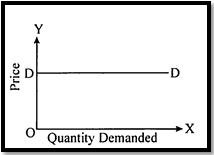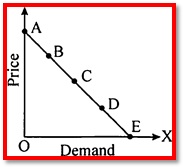MULTIPLE CHOICE QUESTIONS
Q.l. Law of demand indicates the relationship between .
(a) income of a consumer and quantity demanded
(b) price of a commodity and quantity demanded
(c) price of one commodity and price of a substitute
(d) prices of two commodities
Ans. (b) price of a commodity and quantity demanded
Q.2. Identify the inferior good :
(a) Dalda ghee (b) Desi ghee (c) Readymade garments (d) Television
Ans. (a) Dalda ghee
Q.3. With the increase in income, the demand for inferior goods .
(a) does not change (b) increases (c) decreases (d) none
Ans. (c) decreases
Q.4. Which of the following is a pair of complementary goods ?
(a) Tea and coffee (b) Car and petrol (c) Pen and ballpen (d) None
Ans. (b) Car and petrol
Q.5. In case of two complimentary goods, a rise in one of the goods will induce .
(a) an upward shift of demand for the other good
(b) a rise in the price of the other good
(c) a backward shift in demand for the other good
(d) no shift in the demand for other good
Ans. (c) a backward shift in demand for the other good
Q.6. Which of the following is a pair of substitute goods ?
(a) Bread and butter (b) Ink and pen
(c) Car and petrol (d) Tea and coffee
Ans. (d) Tea and coffee
Q.7. Which of the following does not result in increase in demand ?
(a) Increase in income. (b) Change in taste of consumers.
(c) Price of the good. (d) Price of related goods.
Ans. (c) Price of the good.
Q.8. Which of the following results in contraction in demand ?
(a) Price of related goods. (b) Change in taste of consumers.
(c) Price of the good. (d) Fall in income.
Ans. (c) Price of the good.
Q.9. Increase in demand results in ________.
(a) downward movement along the demand curve
(b) upward movement along the demand curve
(c) shifting of demand curve to the right
(d) shifting of demand curve to the left
Ans. (c) shifting of demand curve to the right
Q.10. When demand curve is vertical parallel toy-axis, there will be________.
(a) unitary elastic demand (b) perfectly elastic demand
(c) perfectly inelastic demand (d) relatively elastic demand
Ans. (c) perfectly inelastic demand
Q.11. On a straight line demand curve, elasticity at the mid-point is _______.
(a) infinity (b) 3 (c) 1 (d) 0
Ans. (c) 1
Q.12. When the price of sugar rises from Rs 30 per kg to Rs 40 per kg, there is no change in the demand for sugar and demand remains 200 kgs. What is the price elasticity of demand ?
(a) 0 (b) 0.5 (c) 1 (d) 5
Ans. (a) 0
Q.13. A 5% fall in the price of X leads to a 10% rise in demand for X. What is the price elasticity of demand for the good X ?
(a) 0 (b) 2 (c) 5 (d) 10
Ans. (b) 2
Q.14. The demand for a good is said to be inelastic when the percentage change in quantity demanded is the percentage change in the price of the good.
(a) equal to (b) more than (c) less than (d) None
Ans. (c) less than
Q.15. The demand for a good is perfectly inelastic. When change in quantity demanded due to change in its price is __________.
(a) equal to change in price (b) more than the change in price
(c) less than the change in price (d) nil
Ans. (d) nil
Q.16. Edp = 1 means __________ .
(a) no change in demand due to change in price
(b) more proportional change in demand due to change in price
(c) proportional change in demand is equal to proportional change in price
(d) less proportional change in demand than that in price
Ans. (c) proportional change in demand is equal to proportional change in price.
Q.17. 20% increase in price leads to 25% fall in demand. What will be the elasticity of demand ?
(a) Less than 1 (b) Zero (c) More than 1 (d) Equal to 1
Ans. (c) More than 1
Q.18. The demand is perfectly inelastic. When the price of a good is ? 10, Abir demands 20 units. The price increases to ? 30. What will be new demand ?
(a) 30 (b) 20 (c) 10 (d) zero
Ans. (b) 20
Q.19. When quantity demanded does not change at all in response to change in price of the good, the demand for good is said to be
(a) perfectly elastic (b) perfectly inelastic (c) unitary elastic (d) relatively less elastic
Ans. (b) perfectly inelastic
Q.20. When the demand for a commodity expands or contracts to any extent without or with nominal change in price, the demand for commodity is said to be
(a) perfectly elastic (b) relatively elastic
(c) perfectly inelastic (d) unitary elastic
Ans. (a) perfectly elastic
Q.21. In which type of price elasticity of demand, does the demand curve take a shape of rectangular hyperbola ?
(a) Ed = 0 (b) Ed=l (c) Ed = Infinity (d) Ed < 1
Ans. (b) Ed = 1
Q.22. Which type of price elasticity of demand is indicated by the adjoining demand curve ?
(a) Unitary elastic (b) Perfectly inelastic (c) Relatively inelastic (d) Perfectly elastic

Ans. (d) Perfectly elastic
Q.23. Which point on the demand curve shows the unitary elasticity of demand ?

Ans. Point C
Q.24. Identify the good whose demand will not change in spite of rise or fall in price of the good.
(a) Cosmetics (b) Salt (c) Garments (d) Television.
Ans. (b) Salt
Q.25. Identify the good whose demand for the good is elastic.
(a) Food grains (b) Medicines (c) Cosmetics (d) Salt
Ans. (c) Cosmetics
VERY SHORT ANSWER TYPE QUESTIONS
Questions of One Mark Each
Q.1. Give meaning of consumer’s equilibrium. [CBSE 2010 ]
Ans. Consumer’s equilibrium may be defined as the situation under which a consumer gets maximum level of satisfaction with his given money income and given market prices of the commodities.
Q.2. Mention two approaches used for consumer’s equilibrium.
Ans. (i) Utility analysis (ii) Indifference curve analysis.
Q.3. Define utility. [CBSE 2010]
Ans. Utility may be defined as want satisfying power of a commodity.
Q.4. Define total utility.
Ans. Total utility may be defined as the total satisfaction derived by a consumer from the consumption of total number of units of a particular good.
Q.5. Give the meaning of marginal utility. [CBSE 2010]
Ans. Marginal utility may be defined as the satisfaction derived by a consumer from the consumption of additional unit of a particular good.
Q.6. How is total utility related to marginal utility?
Or
How is total utility derived from marginal utilities?
Ans. Total utility is derived by adding marginal utilities of a particular good. TU = £MU
Q.7. State the law of diminishing marginal utility.
Ans. According to law of diminishing marginal utility, as a consumer consumes successive units of a commodity, its total utility increases (up to a certain level) but at diminishing rate.
Q.8. State the law of equi-marginal utility.
Or
State the consumer’s equilibrium on the basis of utility analysis.
Ans. A consumer will be at equilibrium when he spends his income in such a way that the marginal utility derived from a commodity is just equal to its price.
Q.9. Name the law according to which a consumer with a given income allocates his expenditure among commodities so that the last rupee spent on each brings equal marginal utility.
Ans. Law of Equi-marginal utility.
Q.10. State the condition of consumer’s equilibrium in case of a single commodity.
Ans. MUX = Pv
Q.11. What is meant by monotonic preferences ? [CBSE 2014]
Ans. Monotonic preferences means that between any two bundles, the consumer prefers the bundle which has more of at least one of the goods and no less of the other good as compared to the other bundle.
Q.12. State the condition of consumer’s equilibrium in case of two commodities.
Ans. MUx/Px = MUy/Py = MU of money
Q.13. If a consumer has monotonic preferences, can she be indifferent between the bundles (10, 8) and (8,6) ?
Ans. No, if a consumer has monotonic preferences, she cannot be indifferent between the bundles (10, 8) and (8, 6). She would prefer the bundle (10, 8) to (8, 6).
Q.14. Suppose a consumer’s preferences are monotonic. What can you say about her preference ranking over the bundles (10,10), (10; 9) and (9,9) ? [Textbook Question]
Ans. When a consumer’s preferences are monotonic, the bundles will be ranked as under:
Bundle Rank
(10,10) I
(10,9) II
(9,9) III
Q.15. Suppose your friend is indifferent to the bundles (5,6) and (6,6). Are the preferences of your friend monotonic ? [Textbook Question]
Ans. No, if our friend is indifferent to the bundles (5, 6) and (6, 6), his preferences are not monotonic. As a monotonic consumer, he should prefer (6, 6) over (5, 6).
Q.16. Define an indifference curve. [CBSE 2010, 2014]
Ans. Indifference curve may be defined as the curve depicting the various alternative combinations of two goods which provide the same level of satisfaction tc. the consumer.
Q.17. Why is an indifference curve downward sloping ?
Ans. Due to monotonicity of preferences.
Q.18. Define an indifference map. [CBSE 2010, 2014]
Ans. Indifference map is the collection of indifference curves representing the whole range of satisfaction levels of a consumer. Indifference map represents what a consumer will like to have.
Q.19. What does an indifference curve to the right represent ?
Ans. An indifference curve to the right represents a higher level of satisfaction.
Q.20. What is the shape of the indifference curve ?
Ans. An indifference curve is downward sloping and convex towards the origin.
Q.21. What is meant by rate of substitution ?
Ans. Rate of substitution is the amount of good y that consumer is willing to give up for an extra unit of good x.
Q.22. What does the rate of substitution measure ?
Ans. Rate of substitution measures the consumer’s willingness to pay for good x in term of good y.
Q.23. What is the nature of rate of substitution ?
Ans. The rate of substitution is always diminishing (negative).
Q.24. What does diminishing rate of substitution indicate ?
Ans. Diminishing rate of substitution indicates that the rate of substitution between good x and good y diminishes i.e., consumer’s willingness to pay for good x in terms of good y goes on declining as the consumer has more and more of good x.
Q.25. What is marginal rate of substitution of y for x (MRSyx) ?
Ans. Marginal rate of substitution is the rate by which amount of y is sacrificed to obtain one additional unit of x.
Q.26. Why is MRS continuously falling ?
Ans. MRS is continuously falling because the consumer is willing to sacrifice less and less of y to obtain one additional unit of x.
Q.27. Define budget set. [CBSE 2011, 2014]
Ans. Budget set may be defined the collection of all bundles of goods that a consumer can buy with his income at the prevailing (current) market prices.
Q.28. When does a budget set change ?
Ans. A budget set changes if either of the two, prices of the commodities or the income of the consumer, changes.
Q.29. What is budget constraint ?
Ans. Budget constraint means the amount of money to be spent by a consumer to buy a bundle (combination) of goods.
And much more Queries……….. for that please download our mobile apps from Play-store
https://play.google.com/store/apps/developer?id=Sanjeev+Mehta
Or

